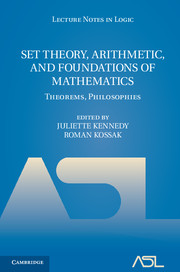Refine search
Actions for selected content:
5849 results in Programming Languages and Applied Logic
Contents
-
- Book:
- Introduction to Bisimulation and Coinduction
- Published online:
- 05 August 2012
- Print publication:
- 13 October 2011, pp v-viii
-
- Chapter
- Export citation
4 - Processes with internal activities
-
- Book:
- Introduction to Bisimulation and Coinduction
- Published online:
- 05 August 2012
- Print publication:
- 13 October 2011, pp 108-132
-
- Chapter
- Export citation
2 - An introduction to (co)algebra and (co)induction
-
-
- Book:
- Advanced Topics in Bisimulation and Coinduction
- Published online:
- 05 November 2011
- Print publication:
- 13 October 2011, pp 38-99
-
- Chapter
- Export citation
3 - Algebraic properties of bisimilarity
-
- Book:
- Introduction to Bisimulation and Coinduction
- Published online:
- 05 August 2012
- Print publication:
- 13 October 2011, pp 89-107
-
- Chapter
- Export citation
General introduction
-
- Book:
- Introduction to Bisimulation and Coinduction
- Published online:
- 05 August 2012
- Print publication:
- 13 October 2011, pp 1-10
-
- Chapter
- Export citation
6 - Enhancements of the bisimulation proof method
-
-
- Book:
- Advanced Topics in Bisimulation and Coinduction
- Published online:
- 05 November 2011
- Print publication:
- 13 October 2011, pp 233-289
-
- Chapter
- Export citation
1 - Origins of bisimulation and coinduction
-
-
- Book:
- Advanced Topics in Bisimulation and Coinduction
- Published online:
- 05 November 2011
- Print publication:
- 13 October 2011, pp 1-37
-
- Chapter
- Export citation
Frontmatter
-
- Book:
- Advanced Topics in Bisimulation and Coinduction
- Published online:
- 05 November 2011
- Print publication:
- 13 October 2011, pp i-iv
-
- Chapter
- Export citation
References
-
- Book:
- Introduction to Bisimulation and Coinduction
- Published online:
- 05 August 2012
- Print publication:
- 13 October 2011, pp 235-243
-
- Chapter
- Export citation
3 - The algorithmics of bisimilarity
-
-
- Book:
- Advanced Topics in Bisimulation and Coinduction
- Published online:
- 05 November 2011
- Print publication:
- 13 October 2011, pp 100-172
-
- Chapter
- Export citation
2 - Coinduction and the duality with induction
-
- Book:
- Introduction to Bisimulation and Coinduction
- Published online:
- 05 August 2012
- Print publication:
- 13 October 2011, pp 28-88
-
- Chapter
- Export citation
Appendix A - Solutions to selected exercises
-
- Book:
- Introduction to Bisimulation and Coinduction
- Published online:
- 05 August 2012
- Print publication:
- 13 October 2011, pp 199-230
-
- Chapter
- Export citation

Set Theory, Arithmetic, and Foundations of Mathematics
- Theorems, Philosophies
-
- Published online:
- 07 October 2011
- Print publication:
- 01 September 2011
7 - Conclusion
-
- Book:
- Unification Grammars
- Published online:
- 25 October 2011
- Print publication:
- 30 September 2011, pp 275-276
-
- Chapter
- Export citation
Index
-
- Book:
- Unification Grammars
- Published online:
- 25 October 2011
- Print publication:
- 30 September 2011, pp 307-312
-
- Chapter
- Export citation
6 - Computational aspects of unification grammars
-
- Book:
- Unification Grammars
- Published online:
- 25 October 2011
- Print publication:
- 30 September 2011, pp 213-274
-
- Chapter
- Export citation
Appendix A - List of symbols
-
- Book:
- Unification Grammars
- Published online:
- 25 October 2011
- Print publication:
- 30 September 2011, pp 277-279
-
- Chapter
- Export citation
Appendix C - Solutions to selected exercises
-
- Book:
- Unification Grammars
- Published online:
- 25 October 2011
- Print publication:
- 30 September 2011, pp 284-298
-
- Chapter
- Export citation
2 - Feature structures
-
- Book:
- Unification Grammars
- Published online:
- 25 October 2011
- Print publication:
- 30 September 2011, pp 34-84
-
- Chapter
- Export citation
Contents
-
- Book:
- Unification Grammars
- Published online:
- 25 October 2011
- Print publication:
- 30 September 2011, pp vii-viii
-
- Chapter
- Export citation
